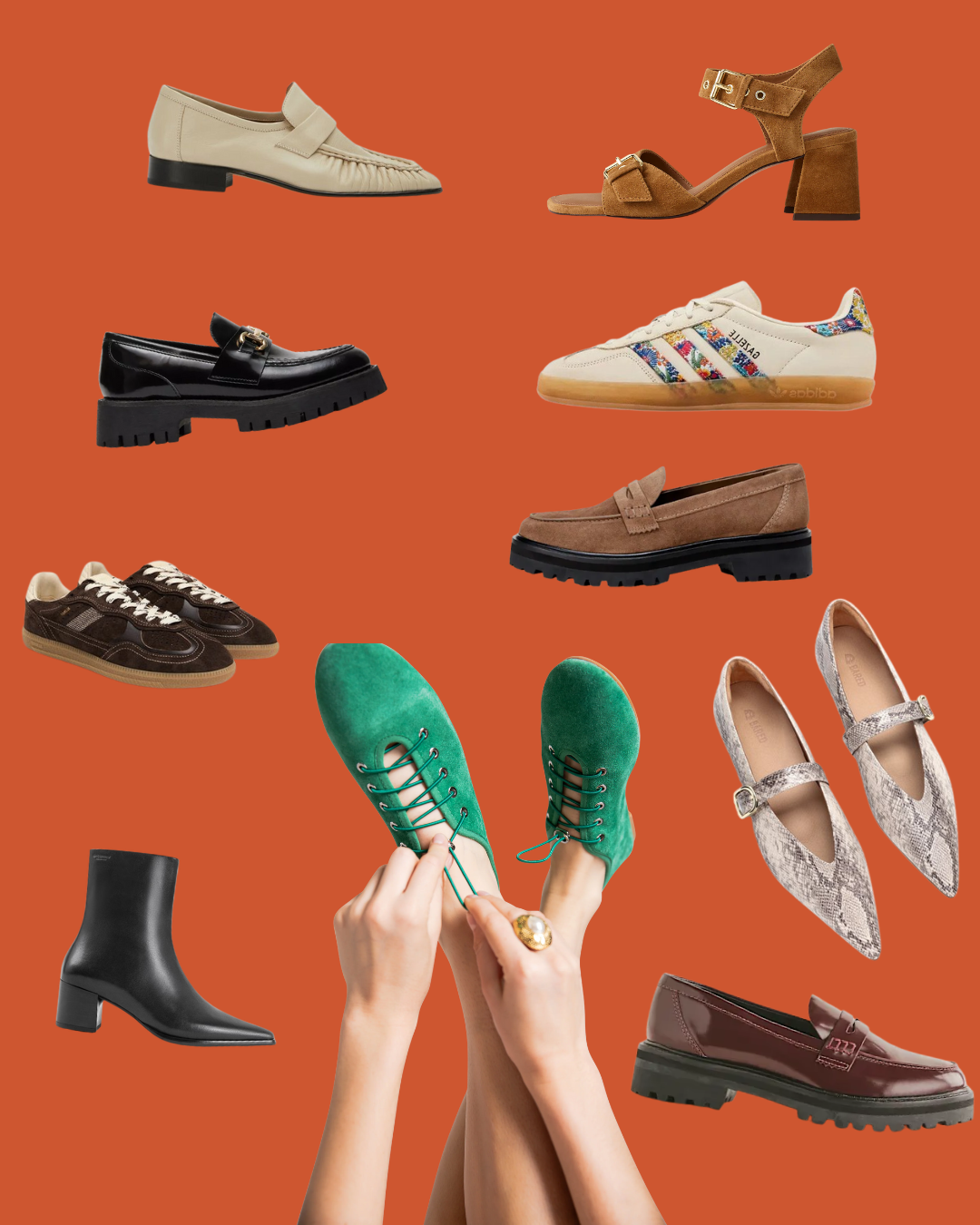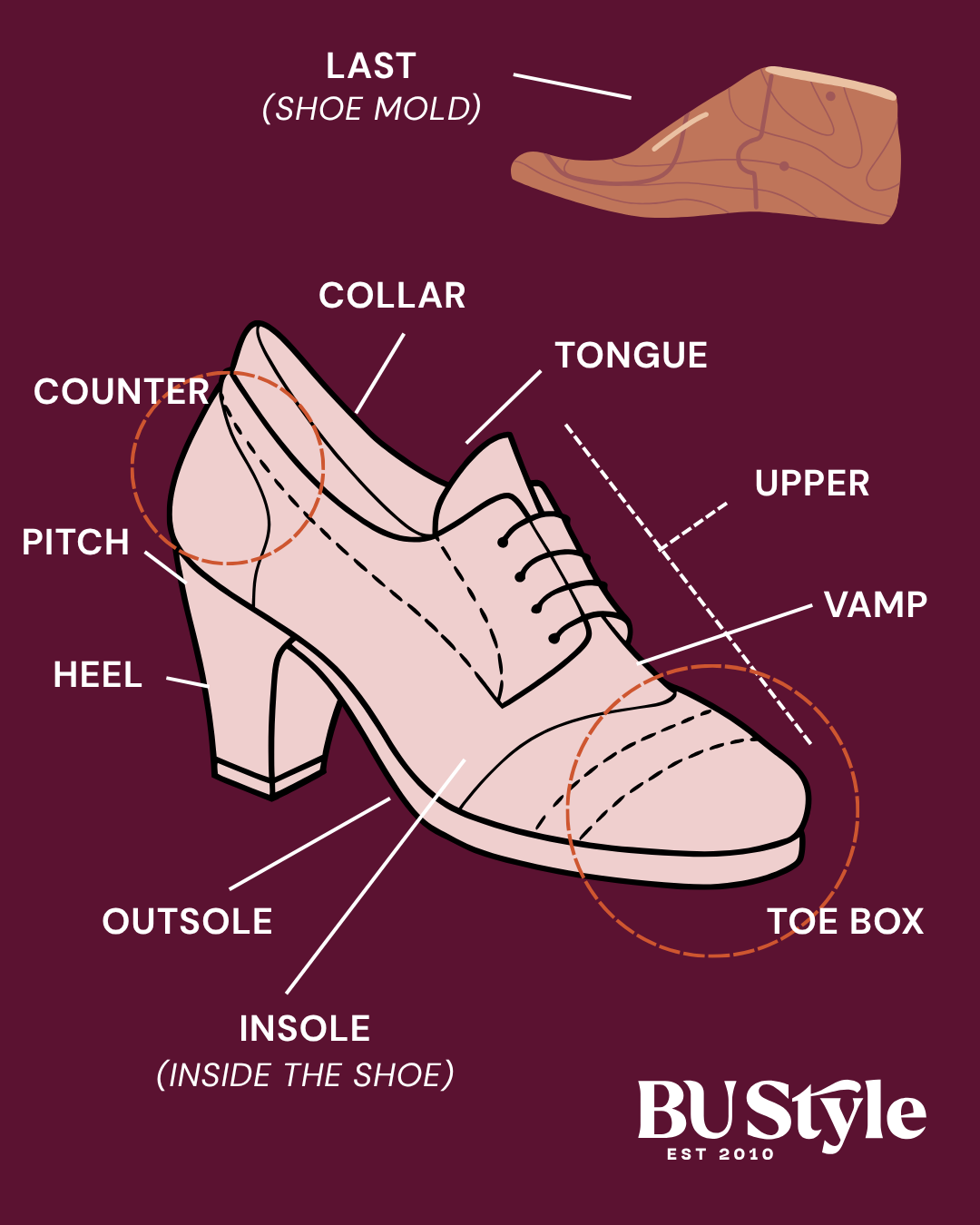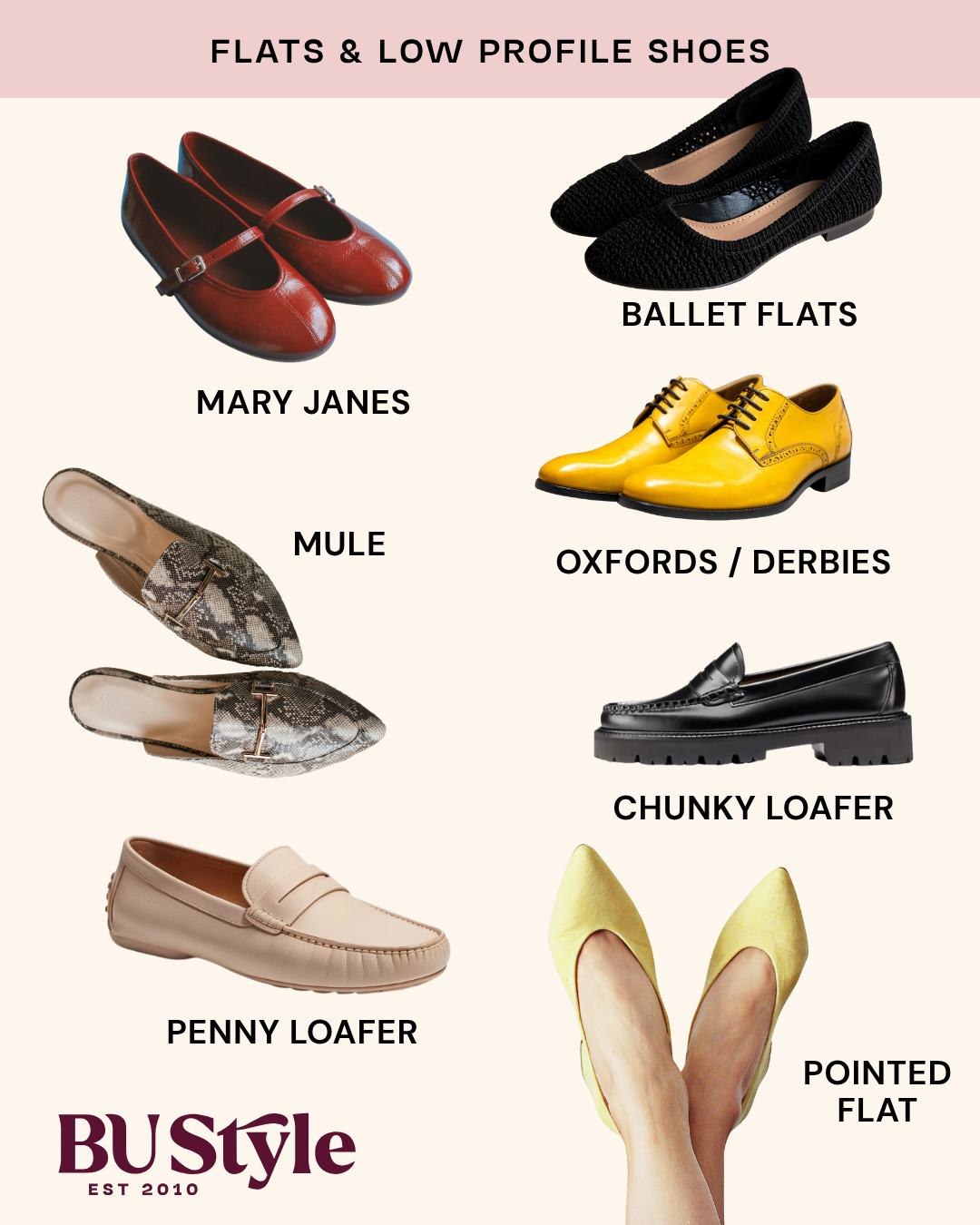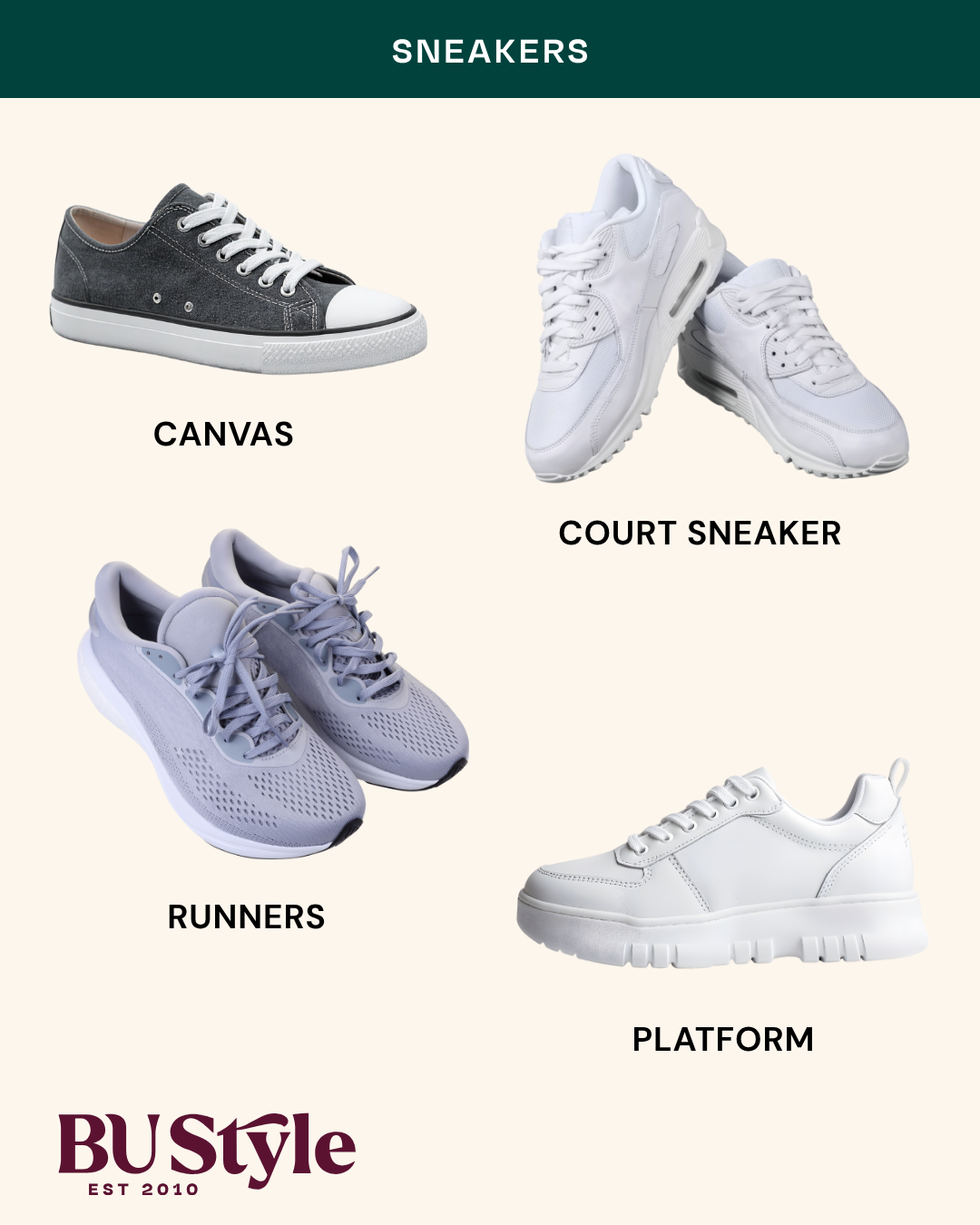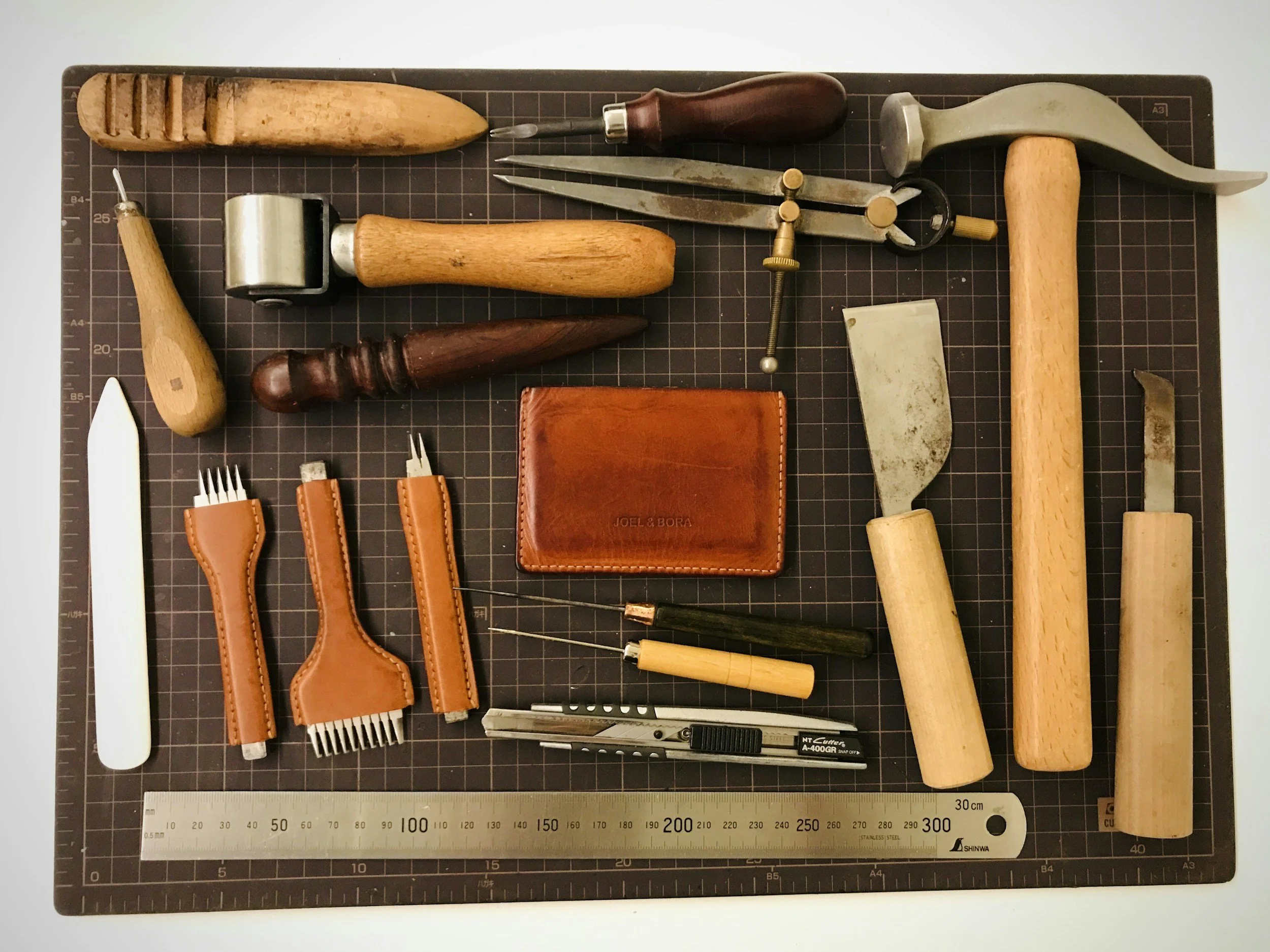Step Into Style: The Complete Shoe Guide for Modern Women
Shoes are not just the period at the end of your outfit sentence. They’re the foundation, the architecture, the quiet enablers that decide whether you sail through your day or hobble home with blisters.
At BU Style, we treat shoes as strategy. They’re not accessories to tack on once you’ve picked your outfit; they’re the pieces that influence your comfort, posture, and confidence from the ground up.
Since the pandemic, so many of us collectively fired the “beauty is pain” rule. (We’ve personally retired our “death trap” 3-plus-inch stilettos once and for all, and our feet still send us thank-you notes.) But here’s the deal: outside of sneakers, a lot of people feel stuck. Where are the comfortable-but-polished, modern-but-wearable shoes that actually work with our updated wardrobes?
This guide is here to demystify it all. Think of it as part style dictionary, part shopping strategy, and part love letter to shoes that support your life—literally and figuratively.
Speak the Language of Shoes
Shoes, like denim, come with their own language. And unless you’re a cobbler, those terms can sound mysterious. Let’s break them down in plain English, with why each one matters for you.
Upper: The entire top part of the shoe: leather, suede, fabric, or synthetic.
👉 Why it matters: The upper determines durability, breathability, and flexibility. The material choice affects how the shoe molds to your foot and how it performs in different settings.
Vamp: The part covering the top of your foot from toe box to instep.
👉 Why it matters: Vamp height changes fit and appearance. A low vamp visually lengthens the leg but offers less security, while a high vamp provides coverage and stability.
Toe Box: The space around your toes: pointed, almond, round, or square.
👉 Why it matters: A properly sized toe box prevents crowding, pressure points, and long-term issues like bunions or hammertoes. Shape also influences the overall look of the shoe.
Heel & Pitch: Heel height is obvious; pitch is the angle your foot sits at, influenced by heel and platform.
👉 Why it matters: Pitch controls weight distribution. A steep pitch increases pressure on the ball of the foot, while a balanced pitch allows longer wear with less strain.
Outsole: The very bottom (rubber, leather, TPU).
👉 Why it matters: The outsole affects traction, shock absorption, and wear. Leather soles are sleek but less durable; rubber offers grip and impact protection.
Counter: The stiffened piece at the heel cup.
👉 Why it matters: A good counter stabilizes the heel, improves balance, and prevents the shoe from slipping. Weak counters can collapse, leading to blisters, ankle strain, and faster wear.
Insole/Footbed: The layer under your foot. Sometimes removable.
👉 Why it matters: Insoles provide cushioning and arch support. Removable footbeds allow customization with orthotics, improving comfort and extending shoe life.
Last: The mold the shoe is built on.
👉 Why it matters: The last controls overall shape, width, and fit. Finding a brand whose last matches your foot ensures consistency across styles.
Widths: How wide the shoe is: N (narrow), M/B (medium), W/D (wide), WW/EE (extra wide).
👉 Why it matters: Proper width ensures even weight distribution and reduces friction. Shoes that are too narrow cause pressure points; shoes that are too wide lead to slipping and loss of support.
✨ BU Style Insight: Knowing your toe box preference, vamp height, and width makes cross-brand shoe shopping so much easier.
Shoe Shapes & How They Work
Shoes aren’t just functional; they sculpt how an outfit looks and feels. Each shape has its own “behavior,” balancing proportions, shifting focus, or grounding a look. None is better or worse; they’re simply tools to tell different style stories.
Flats & Low Profiles
Ballet Flat: The quintessential flat: delicate, low vamp, often rounded toe. Effortless and feminine, these can feel Parisian one moment and prep school the next.
Stylist Tip: Choose a pair with a cushioned insole or tiny block heel for real comfort. Your arches will thank you.
Mary Jane: Classic straps across the instep, now reimagined in modern versions from minimal to chunky. They can blend sweetness with stability.
Stylist Tip: Play with finishes for fun: patent gives a cheeky, retro shine, while suede adds softness and texture.
Pointed Flat: A flat with an elongated toe that mimics the polish of a heel. Sleek, refined, and versatile for work or play.
Stylist Tip: Great with cropped both trousers or wide-legs where you want sharp lines without extra height.
Mule: Backless slip-on, with either closed or open toes. Instantly chic, but practical only if they stay secure.
Stylist Tip: When trying them on, do a few laps indoors—up and down the store aisle or around your living room if ordered online. A good mule should “hug” your foot enough to stay put without gripping your toes.Loafers, Oxfords & Derbies
Classic Loafer: Structured, timeless, and genderless—an anchor in many wardrobes. They ground looks with ease.
Stylist Tip: For a softer alternative to black, try them in rich brown or burgundy.
Chunky Loafer: A modern update with lug soles and exaggerated proportions. Adds weight and presence.
Stylist Tip: Let the loafer set the tone. Pair with floaty pieces for contrast, or lean into structure with trousers and a blazer. They’re versatile enough to swing either way.
Sleek Penny/Bit Loafer: Slimmer, streamlined versions that lean dressier. These nod to heritage style without feeling stuffy.
Stylist Tip: A metallic bit detail can double as jewelry for your feet, instantly elevating denim or trousers.
Oxfords/Derbies: Tailored lace-ups with heritage roots. Oxfords are more formal with closed lacing; derbies are slightly more relaxed with open lacing.
Stylist Tip: Use them to add polish where sneakers might feel too casual. They look sharp with cropped trousers, and the contrast against softer pieces—like a dress or skirt—can add juxtaposition to an outfit.
Heels & Dress Shoes
Kitten Heel: A 1–2’ heel with a narrow heel. Feminine without the wobble.
Stylist Tip: A slingback kitten heel feels especially timeless and transitions seamlessly from office to evening.
Block Heel: Wider heel base, great for stability and comfort. Comes in low, mid, or high versions.
Stylist Tip: Your best friend for weddings and events when you are on your feet a lot.
Slingback: Open back with strap support. Polished yet breathable.
Stylist Tip: Works beautifully with cropped pants, showing off the ankle keeps the line clean and chic.
Pump: The archetypal heel: closed toe, full coverage, and usually sleek.
Stylist Tip: Comfort comes down to shape more than height alone. A well-cut pointed toe can feel just as wearable as an almond, while rounder shapes often give extra room. Try different lasts and see which toe shape your foot actually likes; don’t assume one is off-limits.
Boots
Chelsea: Ankle boot with elastic gussets, sleek and minimal. Effortless staple.
Stylist Tip: Black Chelseas are classic. Try a lighter suede pair for spring to instantly freshen up denim looks.
Mid-shaft Boot: Boots that rise midway up the calf. Modern and endlessly practical.
Stylist Tip: A close-fitting mid-shaft boot slides cleanly under a variety of trouser cuts—straight, full-length, even wider hems. Try them on with your pants and make sure the hem glides over the shaft without catching.
Knee-high: Hits at or just below the knee. Dramatic and elongating.
Stylist Tip: Wear them under dresses or skirts in colder months as both a stylish choice and a practical insulation.
Western: Pointed toe, angled heel, decorative stitching. Adds personality and a hint of rebellion.
Stylist Tip: Let them be the statement. Western boots can ground casual denim just as easily as they add contrast to dresses and skirts—versatile, bold, and never boring.
Combat/Lace-up: Chunky sole, utilitarian laces, durable construction. Adds edge and grit.
Stylist Tip: Learn into 90s grunge with these. Soften the toughness by pairing with a midi skirt or flowy dress.
Sneakers
Court Sneaker: Minimal leather sneaker inspired by tennis shoes. Clean, modern, office-friendly.
Stylist Tip: A white pair is the ultimate wardrobe chameleon that you can style with suiting or denim alike.
Runner Sneaker: Sport-inspired, cushioned, designed for comfort.
Stylist Tip: Keep colors more neutral if you want them to pull double duty for casual wear, not just workouts.
Platform Sneaker: Adds height without sacrificing comfort. Balances proportions.
Stylist Tip: Platforms can shift the vibe of even simple outfits—giving jeans, dresses, or trousers a little extra lift. They’re an easy way to add presence without wearing a heel.
Canvas Classic: Breathable, lightweight, and casual. A summer essential.
Stylist Tip: Embrace the scuffs and let them age like your favorite denim jacket.
Sandals
Slide: Backless, easy slip-on. Minimalist but not always supportive.
Stylist Tip: Look for cushioned soles or wider straps if you want them to last more than just a walk to the pool.
Strappy Sandal: Multiple straps in flat or heeled versions. Elegant and secure.
Stylist Tip: Metallic or nude strappy sandals are event heroes and go with nearly everything.
Fisherman Sandal: Closed-toe woven straps with breathable coverage. Functional yet trendy.
Stylist Tip: Ideal for city summers, these shoes keep toes covered while remaining airy and versatile.
Wedge/Flatform: Height without pitch, thanks to even platform soles.
Stylist Tip: Raffia or cork versions are summer vacation staples, while leather styles transition into city life with ease.
✨ BU Style Insight: Shoes don’t just carry you, they frame your entire look. The more you understand each silhouette’s “behavior,” the easier it is to pick pairs that complement your wardrobe instead of competing with it.
A Guide to Materials & Finishes
Shoes don’t just differ by shape—the material and finish can completely change how they feel, wear, and communicate style. Think of it as the shoe’s personality: structured or soft, glossy or matte, breathable or weatherproof. Knowing your materials helps you predict not only comfort but also longevity and care needs.
Smooth Calf Leather: Structured, durable, and polished. It holds its shape well and breaks in beautifully over time, molding to your foot.
Stylist Tip: Ideal for investment pairs like loafers, pumps, or boots that you’ll wear for years.
Nappa / Glove Leather: Supple and buttery-soft from day one. Molds quickly to your foot but creases sooner than calf leather.
Stylist Tip: Choose for comfort right out of the box, but accept that they’ll develop a more “lived-in” look faster.
Patent Leather: Recognizable for its glossy, mirror-like finish. It adds instant polish and makes even simple outfits feel statement-worthy. Patent tends to be stiffer than other leathers, so it may take time to soften with wear.
Stylist Tip: Use patent when you want your shoes to be the star—perfect for evening, events, or when a touch of shine sets the mood. Keep them away from scuffs, as marks are harder to hide.
Suede / Nubuck: Soft, matte, and rich in texture. Suede has a velvety nap; nubuck is lightly sanded for a smoother finish. Both feel luxurious but are vulnerable to water and stains.
Stylist Tip: Treat with a protectant spray before wear. A suede brush can refresh the nap and extend its life.
Textiles (Canvas, Knits, Mesh): Casual, breathable, and lightweight. Found in sneakers, espadrilles, and summer shoes. They’re easy to wash or spot-clean but wear down faster than leather.
Stylist Tip: These are great everyday options, especially in warmer months or for active lifestyles. Just know they’ll show wear sooner—so keep a rotation or spot-clean regularly if you want them to stay fresh. Otherwise, lean into the wear!
Vegan Leathers / Synthetics: Ranges from high-quality plant-based or recycled materials to cheaper, plasticky versions. Performance varies widely.
Stylist Tip: Vegan leather has come a long way in recent years and can be soft, durable, and eco-conscious.
Rubber / TPU Soles: Flexible, durable, and weather-resistant. Great for shock absorption and grip. Found in sneakers, boots, and modern loafers.
Stylist Tip: Consider rubber soles if you live in wet or icy climates. It adds safety and comfort without sacrificing style.
Leather Soles: Classic, sleek, and refined—common on dress shoes. They feel elegant but can be slippery and wear down quickly on concrete.
Stylist Tip: Extend their life by having your cobbler add sole protectors (like Vibram). This service can double durability.
Special Finishes (Embossed, Metallic, Exotic Textures): Leathers or synthetics treated with unique effects—snakeskin embossing, croc stamp, foil metallics, velvet, or glitter.
Stylist Tip: Treat them like jewelry for your feet. One special-finish pair can elevate a look and add dimension and interest.
✨ BU Style Insight: Choose materials based on lifestyle and intention. Need structure for the office? Go with calf leather. Want softness from day one? Nappa delivers. Craving shine for events? Patent is your pick. Prefer texture or artistry? Suede brings it. Running errands or commuting daily? Canvas and knits keep things light. Facing wet or icy weather? Rubber soles win. The right material should match both your lifestyle and your personal style.
Shoe Sizing and How Shoes Should Fit
Shoes are a relationship—don’t start on a bad one. The right fit isn’t just about comfort in the moment; it’s about long-term health for your feet, knees, and back. Here’s how to test shoes before they earn a place in your wardrobe:
Shop later in the day
Feet swell as the hours pass, so a shoe that feels fine at 10am may pinch by 4pm. Always try new shoes in the late afternoon when your feet are at their largest.
Wear real socks or tights
Match the socks, hosiery, or insoles you’ll actually wear with the shoe. A pump that fits barefoot may feel tight with tights; sneakers fit differently with performance socks than with thin cotton ones.
Do the Stand–Sit–Walk Test
Stand: Your toes shouldn’t press against the end.
Sit: Your heel shouldn’t lift or slip.
Walk: Take a few laps. Shoes should feel balanced, secure, and comfortable in motion.
Don’t count on “they’ll stretch”
Yes, leather can give a little—but if the shoe feels tight all around, it’s a red flag. Stretching should be for small trouble spots (a bunion, a pinch on one foot), not for making an overall too-small shoe wearable.
Explore widths
Widths are as important as length. Too narrow = pressure points and bunions. Too wide = slipping and blisters. Once you know your width (N, M/B, W/D, WW/EE), you’ll shop smarter across brands.
Orthotics & Insoles
If you wear custom orthotics, removable insoles are key. Even if you don’t, swapping in better insoles can completely change a shoe’s comfort and longevity.
✨ BU Style Insight: If your shoulders drop and you feel relaxed when you walk in them, that’s a yes. If you’re already planning which Band-Aids to buy, it’s a no.
Shoe Care: Love Them Longer
Shoes are one of the most important investments in your wardrobe. They literally carry you through your days, and with the right care, they can last for years—sometimes decades. Protecting them isn’t just about keeping them pretty; it’s about maintaining their structure, comfort, and lifespan. Think of it as style maintenance that saves you money (and blisters) in the long run.
Day One: Start Smart
When you bring a new pair home, don’t just toss the box and wear them out the door. A little prep sets you up for success.
Spray suede and light leathers: A water and stain protectant makes a huge difference in how they weather city streets. Note that some shoes are pre-treated, so make sure you ask or check the details.
Add sole protectors or Vibram overlays: Especially for thin leather soles. This one step can double the life of a shoe.
Toe taps for pointy shoes: A tiny addition that prevents scuffing and keeps them looking polished longer.
Ongoing: Simple Habits
A few small rituals help keep shoes fresh from day to day.
Wipe down, brush, polish: A quick once-over after every few wears prevents buildup and keeps materials supple.
Use cedar shoe trees: For structured shoes, they maintain shape, absorb moisture, and keep shoes smelling clean.
Rotate pairs: Cushioning (and your feet!) need recovery time. Wearing the same pair every day breaks them down faster.
Seasonally: Give Them a Spa Day
At least once a season, let your shoes have some professional TLC. A good cobbler can work magic.
Heel caps: Replace before they wear down completely to avoid damaging the heel itself (and making that AWFUL metal on concrete sound. You know the one!)
Resole: Extends life dramatically, especially for boots and loafers.
Stretch: Pinpoint tight spots for a custom fit without the blisters. A good cobbler can professionally stretch trouble spots.
Polish & shine: Brings leather back to life so shoes look (and feel) like new.
✨ BU Style Insight: Build your “style support team.” A trusted cobbler is as essential as a good tailor. They can revive old favorites, save new pairs from early retirement, and keep your investments looking their best.
A Professional Woman’s Guide to Shoes for Each Setting
Shoes don’t just finish an outfit—they help set the tone of how you’re perceived in different environments. The same pair that feels perfect on a Saturday afternoon may feel off in a boardroom. The good news? You don’t need dozens of pairs to cover every situation—you just need the right ones, chosen with intention for the settings you move through most.
Corporate & Formal Offices
In industries like law, finance, or other traditional workplaces, polish is a non-negotiable.
Best bets: Sleek loafers, pumps, block heels, slingbacks, pointy flats, and refined dress boots.
Why it works: These silhouettes communicate authority, reliability, and attention to detail.
Tip: Stick to smooth leather or subtle suede in darker tones. Avoid overly trendy shapes or chunky soles that can distract from the professional message.
Business Casual
This is the most common dress code, and it’s also the trickiest because the rules vary from office to office.
Best bets: Loafers, structured flats, ankle boots, and polished sneakers (If you see peers and managers wearing them, think leather court sneakers, not gym shoes).
Why it works: These choices hit the sweet spot between professionalism and comfort.
Tip: Look around: if your manager wears sneakers, it’s likely safe. If not, stick to non-sneaker biz casual options.
Smart Casual
Think networking events, dinner out, or offices that want polish without stiffness.
Best bets: Slingbacks, chic ankle or mid-shaft boots, low block heels, loafers, non-athletic sneakers.
Why it works: These shoes add refinement without tipping into formality.
Tip: Smart casual is where material really matters—suede, metallic accents, or patent details can instantly elevate the simplest outfit.
Creative & Tech Workplaces
Here, shoes aren’t just functional, they’re conversation pieces. Individuality is celebrated, as long as the look feels intentional.
Best bets: Platform sneakers, Mary Janes, Western boots, bold loafers, or statement sneakers.
Why it works: Personality matters more than polish in these settings. The right shoe can signal creativity while still looking sharp.
Tip: While freedom is celebrated, most offices still expect shoes to be clean and in good repair—and you should want the same!
✨ BU Style Insight: The darker, sleeker, and more structured the shoe, the more formal it reads. The lighter, softer, or more casual the material and shape, the more relaxed it feels. Use this to your advantage—shoes are one of the quickest ways to shift your outfit up or down the formality scale.
Trends & Building Your Shoe Portfolio
Trends will always come and go, but that doesn’t mean your shoe wardrobe needs a constant overhaul. The key is knowing yourself: your style personality, lifestyle, and comfort needs. When a shoe checks those boxes and adds mileage to the trousers, dresses, and jeans you already own, it’s a winner. And if a trend happens to support that need? Even better! Strike while it’s hot.
Think of it this way: every era has its “it” shoes. Ballet flats, Mary Janes, loafers, slingbacks, block heels, Western boots, platform sneakers: each has cycled in and out of fashion for decades. The question isn’t what’s trending now, but which of these classics-in-rotation actually works for you?
That’s why we prefer to think in terms of a shoe portfolio that’s part of your mix-and-match ‘core’drobe. A well-rounded mix ensures you always have the right shoe for your outfits without needing to own dozens of pairs. Most of our clients find they’re really just missing one or two strategic categories. For example, the pair that makes their wide-leg trousers work more easily or the event shoe that lets them stop dreading standing—or dancing—on their feet for hours at weddings. Once those gaps are filled, everything else falls into place.
Here’s a sample framework to cover the bases:
Daily driver: A sleek loafer, pointed flat, or low heel that plays well with both denim and trousers.
Mid-shaft boot: The quiet hero for modern pant silhouettes.
Polished sneaker: Leather or court-style for days when comfort leads.
Shoulder-season shoe: That spring/fall gap-filler when sandals and boots don’t for with the weather
Event shoe: Walkable elegance: block heels, padded pumps, kitten heels, or refined flats.
Casual hero: Slides, sandals, or easy sneakers that carry weekends.
From there, rotate neutrals and textures with the seasons—ivory leather or woven rattan in spring, espresso suede or oxblood polished leather in fall—and let one or two statement pairs (patent, metallic, embossed, or bold color) add personality to the mix.
✨ BU Style Insight: The “right” shoes aren’t about trend-chasing. They’re about alignment. When a pair fits your lifestyle, feels good on your feet, reflects your style personality, and expands what you can wear from your closet—that’s when you know it’s worth the investment.
Final Word from Your Personal Stylists
Shoes are not decoration; they’re enablers. The right pair changes your pace, posture, and presence. There’s no universal perfect shoe—just the pair that supports your days and your style goals and allows you to move with confidence.
If your shoe shelf still feels like a puzzle, you don’t have to solve it alone. Inside BU Style Circle, we help you map shoe gaps, create a Strategic Shopping List, and talk through outfit-to-shoe pairings in live Q&As.
In the end, your shoes don’t just finish your outfit; they carry you through your life.
Your Shoe Resource Hub
👢Strategize, Shop, & Style
Explore BU Style’s curated Shoe Guide (updated seasonally with vetted recommendations).
Read our tips in InStyle: “The 10 Best Chunky Loafers to Level Up Your Wardrobe” (August 2025)
Join BU Style Circle for access to our Strategic Shopping List tool, additional shopping guides, the BU Style Six assessment, live support, and more!
🎧 Listen
Wear Who You Are podcast episodes:
Episode 36: Finding Your ‘Sole’Mate
Episode 39: Shoe Care & Repair for Lasting Wear
👞 Shoe Care
Visit and shop our Shoe Care guide catalog

